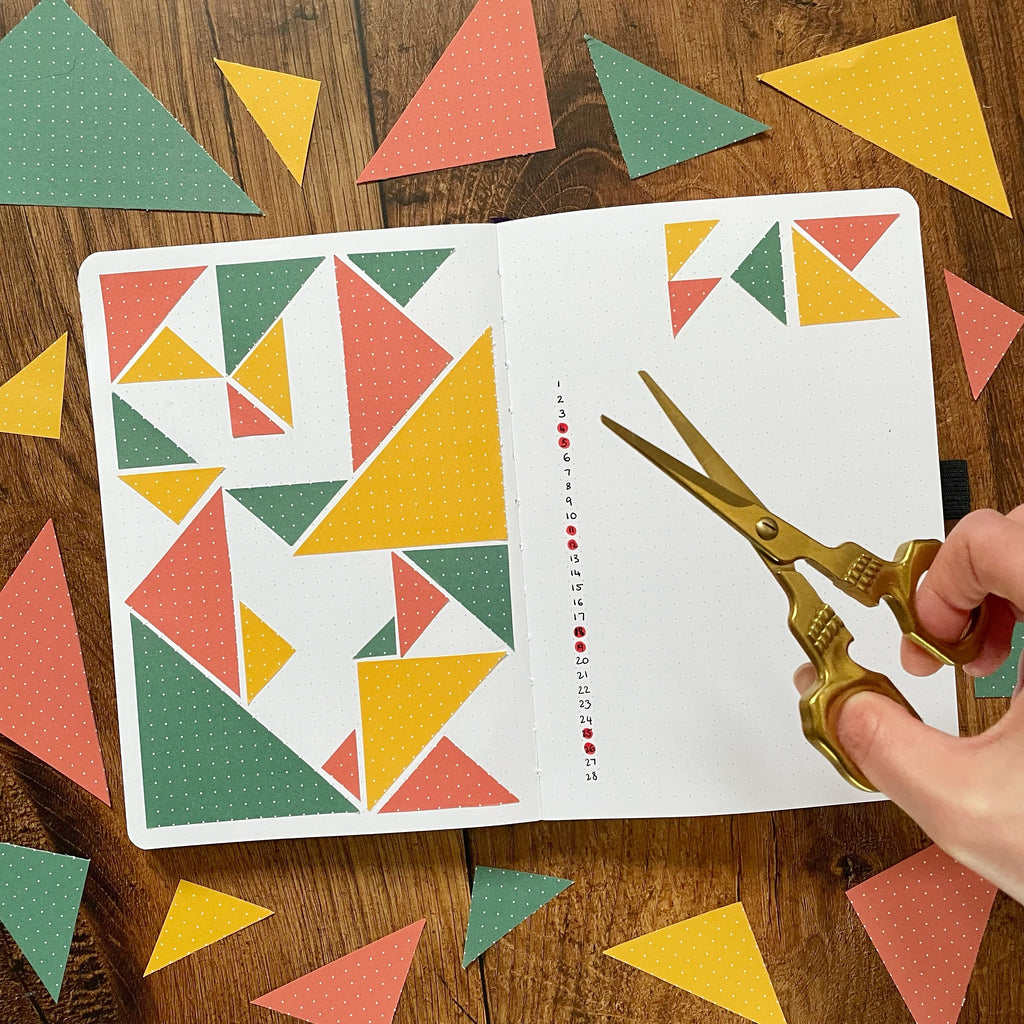How to Keep Going with Bullet Journaling When You Feel Like Quitting

Are you thinking of quitting bullet journaling? Don’t throw in the towel just yet! Of course, journaling isn’t for everyone but if you’re currently struggling with one of these reasons, this blog post might help:
- Your bullet journal doesn’t look like the ones on Instagram and Pinterest
- You don’t have time to set up your bullet journal spreads
- You can’t keep up with all of your spreads and trackers
- You’re overloading yourself with tasks
- Your supplies aren’t working for you
- You just forget to use it!
Some of the reasons and solutions overlap, but let’s go through them one by one…

“My bullet journal doesn’t look like the ones on Instagram and Pinterest”
Comparison is the thief of joy and I have fallen foul of this with SO many of my hobbies. (Let’s not talk about my Animal Crossing island!) It can be wonderful to find inspiration online from others who share your passion, but if seeing other people’s picture-perfect journal spreads is getting you down, it might be best to avoid them for a while. Mute, unfollow, whatever you need to do.
If you’re looking for some less intimidating inspiration, seek out minimalist bullet journalers for spread ideas and layouts that don’t make you feel like your journal isn’t good enough because - spoiler - that’s not true! Here’s a few to check out:
- Oh No Nina (YouTube)
- This video from Pick Up Limes (YouTube)
- Minimalist Bullet Journals (Facebook group)
- Bullet Journal: Minimalist Layouts (Facebook group)
- @lines.and.lettering (Instagram)
- @bulletjournal.minimalist (Instagram)
- 8 minimalist bullet journal weekly spread layouts to try (blog post)

It’s worth bearing in mind that these are still often a polished version of minimalist with clean lines and neat writing, and it’s totally fine if your version is scribbled lists, smudged pen and dog-eared pages!
The bullet journal method itself has absolutely nothing to do with drawing or lettering so there’s no need to decorate it at all if it doesn’t appeal to you. The most important thing is that it helps you, in whatever way you need it to.
Once you’ve nailed the basic method and really made a habit of it, you could start to introduce decoration and illustration if you’re that way inclined, but I definitely recommend approaching it that way round. There’s lots of ways to decorate your spreads if you don’t fancy drawing such as washi tape, stickers, coloured pens and papers, and you can see lots of inspiration over on the blog.

If you’re keen to incorporate illustration or improve your drawing skills, here’s some of the things that I’ve found helpful:
- Practice! Daily, weekly, whatever works for your schedule but I definitely see the most improvement when I’m doing it regularly
- Instagram drawing challenges and prompts such as Inktober as they encourage me to push outside my comfort zone (cough floral line drawings cough) and try something new
- Drawing tutorials from books, Instagram, YouTube and Skillshare - these are really useful if I’m looking for something specific
- Trying different mediums: If you only sketch in pencil, try fineliner. If you only do black line drawings, introduce some colour. If you’ve only drawn on white paper, try a blackout sketchbook. If you’ve never experimented with paints before, try watercolours!
- Tracing! It feels a bit like cheating but I’m always honest about whether I’ve traced an image in my journal. Here’s one of my favourites, and I could never have drawn something like this freehand!

Drawn with a tutorial from one of Alli Koch's botanical line drawing books
“I don’t have time to set my bullet journal up”
Once again, switching to a minimalist set up can be a real help here! You can also make your spreads work harder for you and last longer by creating rolling spreads. Instead of writing the same tasks in every day, why not try a rolling weekly? There’s a few different ways to approach it, so I recommend checking out these videos by Amanda Rach Lee and Plant Based Bride for inspiration. You could also switch up some of your monthly trackers to six monthly or yearly trackers and include them at the start of your journal as I do with my symptom and clothing trackers.
I touched on this in my beginner’s guide to bullet journaling, but I genuinely believe that having a totally customised organisational system in place improves my productivity. While I may spend an hour or two setting up a new month of spreads, it ultimately gives me more time as I’m not scrabbling around to find scraps of paper that I’ve jotted to do lists on, or trying to remember what on earth I’m supposed to be doing that day! It also helps me prioritise my workload and keep track of deadlines and completed tasks. I try to set aside some time on the last Sunday of the month to set up my spreads for the following month, and I really look forward to this moment of quiet creativity.

I keep the majority of my spreads fairly minimal, but I do love making a themed monthly cover page. Without that, I could easily set up my spreads in less than an hour each month. I’ve also recently streamlined the spreads that I include, and have done away with monthly habit trackers and photo pages as I just wasn’t filling them in, which leads me on to my next reason…
“I can’t keep up with all of my bullet journal spreads and trackers”
…then don’t! There’s absolutely no point churning out pages and pages of beautiful Insta-worthy bullet journal spreads that just aren’t serving you. At the end of each month, flick through and see which spreads you did and didn’t use. If there’s any you’re not filling in or giving up on halfway through the month, ask yourself if they really need to be there?
On the other hand, is there another spread you could add that would help you to manage your time more effectively? Are the same things always cropping up on a brain dump page? I’m always experimenting with the spreads I include but my monthlies currently consist of just a cover page, calendar page, freelance timesheets and weekly spreads. You can read more about the spreads I’ve added and removed from my yearly and monthly set ups in this blog post.

“I’m overloading myself with tasks”
Ok, I am definitely still guilty of this! I think I subconsciously feel like I have to fill the whole box with tasks in order for it to be a productive day, which is absolutely not true. If you’re struggling with this too, you could try estimating how long you think each task will take and block out sections of the day. Then when the day gets full, you can’t add any more tasks unless you take something else out!
“My supplies aren’t working for me”
It’s amazing how much of a difference this can make. I’m really heavy handed and find writing on thin paper so frustrating, so discovering Archer & Olive’s 160 gsm journals was such a game changer for me! I think it’s also so important to find the right everyday writing pen for you, whether that’s a ballpoint, gel pen, fineliner or fountain pen.
When I started bullet journaling, I defaulted to writing my daily tasks in the same fineliners I was using to set up my spreads. It wasn’t until I happened to be using a gel pen for something else that I realised how much more comfortable it was to write with, and I switched immediately! I’ve gone through phases of using a fountain pen, but I think the Pentel Energel is the best balance of smooth vs quick-drying for me and my style of journaling.

“I just forget to use my bullet journal”
This is definitely one of the most common reasons I see and hear! So many journalers get out of the habit, feel guilty about it and then aren’t sure how or when to pick it back up. Remember that your bullet journal isn’t a CV or a job interview and you don’t need to explain any gaps in it. It doesn’t matter if it’s been a day, a week, a month or a year, if you feel like you want to start using it again, then go for it! Rather than just diving back in, I’d recommend having a good look through it to decide what to include and how to use it going forward. It’s also worth taking a few proactive steps towards making it a habit. Here’s what’s helped me:
- I leave my bullet journal open on my desk all the time, although I appreciate this may not work for those who don’t work from home, don’t have a separate desk or have snooping children or nibbling dogs to contend with! However, I do think it’s worth assigning your journal a specific place such as the bag you use every day or your bedside table so you always know where it is
- Schedule journaling time into your day. I always look at mine first thing after breakfast, at lunchtime and at the end of the working day so I can check that I’m staying on top of my task list for the day and week. You could try synching these up with daily activities, such as a morning coffee or commute to work

And finally, quite a few people have told me they’d love to bullet journal but can’t because they have ADHD. Interestingly, the creator of the bullet journal system, Ryder Carroll does too, which is precisely what lead him to create it! That’s not to say that it will work for everyone with ADHD, but it’s definitely worth a go. You can read more about Ryder’s experience with ADHD in this article.
If you’re on the fence but not ready to give up yet, I hope that’s given you a little motivation to persevere and some things to try. Bullet journaling is not for everyone and you haven’t failed if it didn’t work for you. I hope you find something that works! If you're definitely team Paper Planner, check out Risotto's range of day, week and month planners, and these gorgeous Undated Weekly Archive Planners!


If you’ve been inspired by any of the suggestions in this post, we’d love to see! Please tag @nikkissupplystore and #NikkisSupplyStore on Instagram, where you can find heaps more journaling and stationery inspiration. You can also follow me, @joy.margot, for more craft content and pictures of my cat, Juniper.



